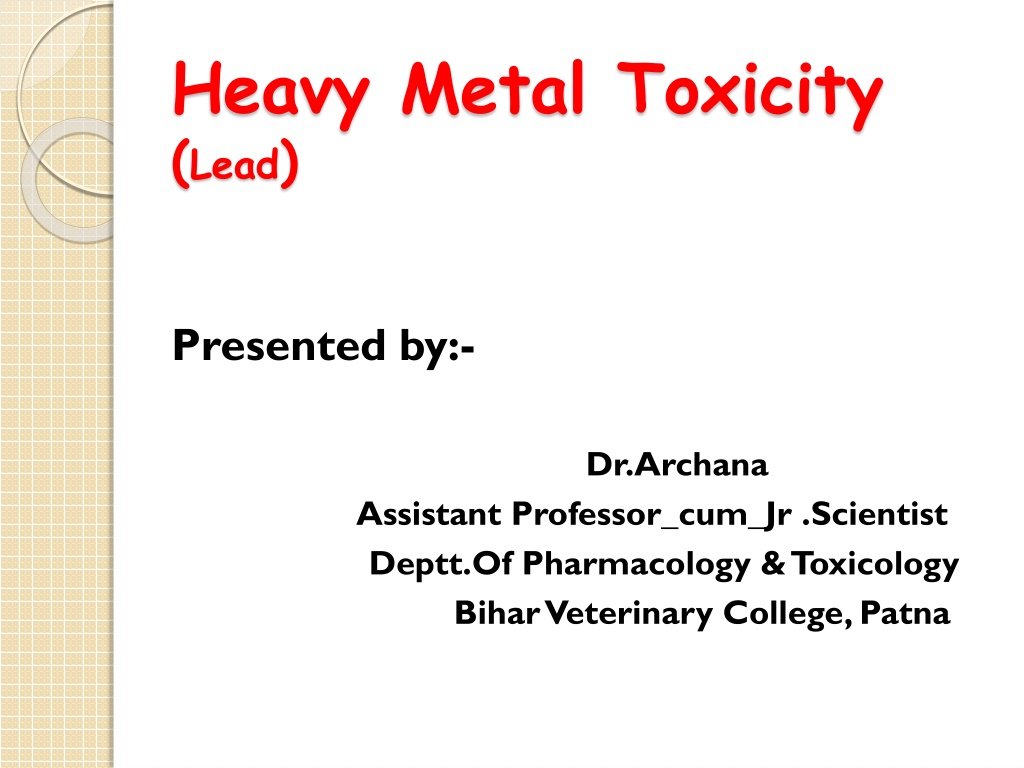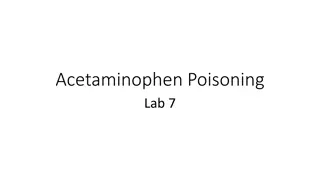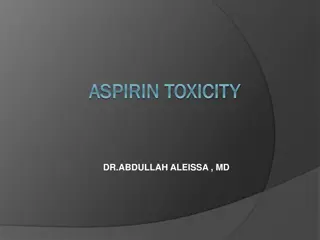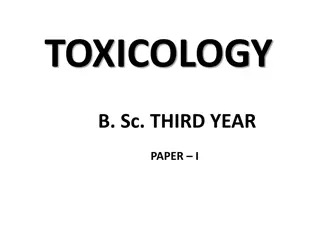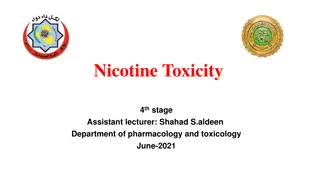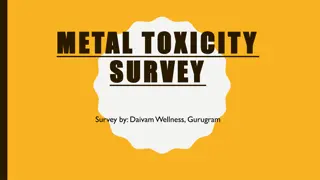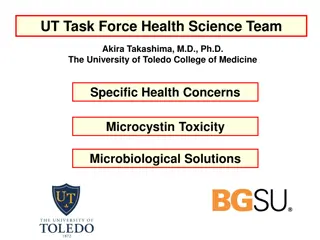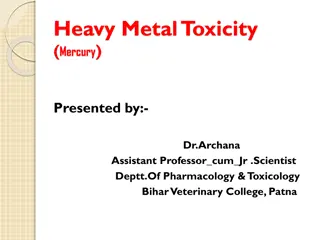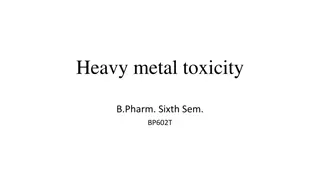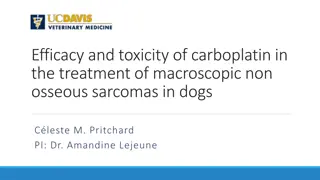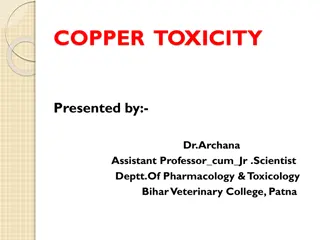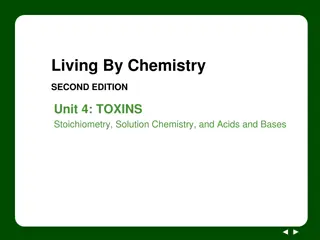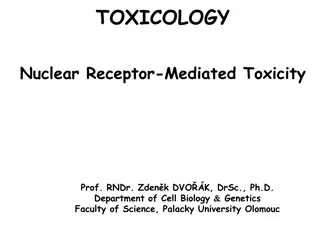Lead Toxicity: Sources, Symptoms, and Treatment in Animals
Lead toxicity, or lead poisoning, can have serious health implications for animals, particularly in cases of ingestion through contaminated sources. This article discusses the sources, toxicokinetic processes, clinical signs, and treatment of lead toxicity in veterinary medicine, highlighting the importance of awareness and prevention to safeguard animal health.
Download Presentation

Please find below an Image/Link to download the presentation.
The content on the website is provided AS IS for your information and personal use only. It may not be sold, licensed, or shared on other websites without obtaining consent from the author.If you encounter any issues during the download, it is possible that the publisher has removed the file from their server.
You are allowed to download the files provided on this website for personal or commercial use, subject to the condition that they are used lawfully. All files are the property of their respective owners.
The content on the website is provided AS IS for your information and personal use only. It may not be sold, licensed, or shared on other websites without obtaining consent from the author.
E N D
Presentation Transcript
Heavy Metal Toxicity (Lead) Presented by:- Dr.Archana Assistant Professor_cum_Jr .Scientist Deptt.Of Pharmacology & Toxicology Bihar Veterinary College, Patna
Content of chapter * Sources * Toxicokinetic * Mechanism of toxicity * Clinical Signs * Treatment
Lead Toxicity Lead poisoning is a medical condition caused by increased levels of the heavy metal lead in the body, and this can interfere with a variety of body processes and causes toxicity to many organs and tissues. It s also called plumbism, colica Pictonum or Saturnism In veterinary medicine lead is one of the most common cause of metallic poisoning in dogs & cattle. Goats, swine and chickens are more resistant.
Source :- Lead poisoning can result when curious animals ingest lead-based paints. In cattle many cases of lead poisoning is associated with seedling and harvesting activities. Feeding on crops sprayed with lead insecticides may also result in lead poisoning in animals. Vegetation grown in lead smelters areas and near highways where plants accumulate lead are other important source of lead poisoning.
Toxicokinetic Absorption:- It is absorp through GIT & respiratory system. The absorption of lead from GIT is very limited (1- 2%) and therefore 98% of lead is eliminated in the faeces. After absorption a large proportion (85-90% in sheep & 65-70% in cattle) of lead in blood is carried to erythrocytes membrane. The fumes from heated lead or very fine particles (< 0.5 m) of lead can enter the lung alveoli.
Distribution After absorption lead is distributed in the soft tissue particularly in the tubular epithelium of kidney & liver. Nearly all circulating blood is bound to erythrocyte, only small fraction is present in unbound form & cause toxicity. It is distributed in the bone, teeth and hair. About 95% of the total body burden of lead is present in the bone & hence bone is considered to be a sink for lead. It crosses placental barrier & blood brain barrier.
Excretion Lead is normally excreted via kidney small amount excreted through bile & sweat. Lead is also excreted in dangerous amount through milk
Mechanism of toxicity The exact mechanism of action is poorly understood even the low concentration of lead inhibits various biochemical process :- Leads depresses aminolevulinic acid(ALA) dehydratase enzyme ( copper containing enzyme) resulting in increase serun level of -aminolevulinic acid and its excretion in urine, this is considered major step invoving lead in biochemical process. Lead appears to inhibit haem synthetase, a thiol containing enzyme which is required to incorporate iron in the haem molecule. It also prevent entry of iron from cytosol to mitochondria.
Clinical Sign The major systems affected by lead poisoning are gastrointestinal, central nervous system & hematological system. GIT Symptoms :- Anorexia, colic, dullness and transient constipation frequently followed by diarrhea can be common clinical signs in animal exposed to excess lead.
Continue.... CNS symptoms :- In cattle there is depression, weakness and ataxia can progress to more severe clinical signs of muscle tremors head pressing ,blindness, jaw champing, muscle tremor and convulsion. Horses develop acute lead toxicosis & show clinical signs of pharyngeal paralysis (roaring) and dysphagia frequently resulting in aspiration pneumonia. Hematological symptoms:- Blood capillaries congested with enlarged and increased endothelial cells. Meningeal blood vessels were prominently congested with mild lymphocytic infiltration. Basophilic stippling (the aggregation of ribonucleic acid) of erythrocytes and inhibition of hemoglobin synthesis are characteristic hematological features of lead poisoning.
Treatment Specific antidotal therapy Disodium calcium EDTA(Ethylene diamine tetra acetate) In horse and cattle it is given intravenously or sub-cutaneously as 1-2% solution in 5% dextrose @ 110mg/kg divided in two treatment daily for 3days. skip for two days & then repeat the dose for two days. In dogs a similar dose divided into 4 treatments a day is given S/c in 5% dextrose for 2-5 days.
Continue.... Thiamine has been shown to be a valuable adjunct to the treatment of lead poisoning in ruminants and is recommended for other species as well. Corticosteroids and osmotic diuretics may reduce cerebral oedema in cattle and horses. Diazepam and barbiturates may be used to control muscle tremor and convulsion.
